
A performance!
Twelfth Night was always a festive event for Jane Austen, her family and friends. They loved to brighten up the winter season and celebrate the traditional Epiphany with a variety of parties, balls, children’s festivities, and most especially theatricals. As we might expect, Jane Austen was at the heart of these activities as a girl at Steventon, and later at house parties with friends. Her own witty skits are thought to have amused her family alongside the plays they acted, and not only at Christmas.
We are fortunate to have a small but genuine glimpse of Jane Austen performing as a comic actress, in all the splendor of her humor and genius, on one singular Twelfth Night. On this occasion, which took place in 1808 at Manydown House, she took the comedy part of Mrs. Candour, and it would be the party event I would most choose to attend could I go back in time!
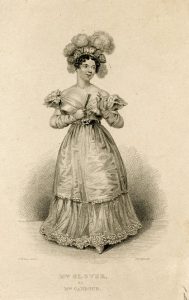
Mrs. Candour
One version of the story tells us that the role involved “taking people aside and telling them candidly what one thought of them, or of their cap and gown, or making outrageous comments in loud whispers about the other guests!” It’s easy to imagine Jane Austen wickedly reveling in such a role.
Other versions have it that Jane Austen actually portrayed the part of Mrs. Candour in Sheridan’s play The School for Scandal. Sheridan was a great favorite of all the Austen family, with Jane said to have taken part as early as the age of eight in a family performance of The Rivals, and later in The School for Scandal. So we may picture her performing the following passage, one of the role’s main speeches. I present to your imagination – Miss Jane Austen as Mrs. Candour!
“Tale-bearers are as bad as the tale-makers – ‘tis an old observation, and a very true one: but what’s to be done? How will you prevent people from talking? Today, Mrs. Clackitt assured me, Mr. and Mrs. Honeymoon were at last become mere man and wife, like the rest of their acquaintance. She likewise hinted that a certain widow, in the next street, had got rid of her dropsy and recovered her shape in a most surprising manner. And at the same time Miss Tattle, who was by, affirmed that Lord Buffalo had discovered his lady at a house of no extraordinary fame; and that Sir Harry Bouquet and Tom Saunter were to measure swords on a similar provocation. But, Lord, do you think I would report these things! No, no! Tale-bearers, as I said before, are just as bad as the tale-makers.”
How Jane Austen must have relished such a speech, and Sheridan’s wit, so congenial to her own, may even have inspired her in creating such a spiteful and similar character as Mrs. Elton in Emma, which she started writing five years later. It is delightful to know that the playwright himself had opportunity to equally appreciate Austen’s own works and humor, for on reading Pride and Prejudice he commented that it was one of the cleverest things he had ever read.
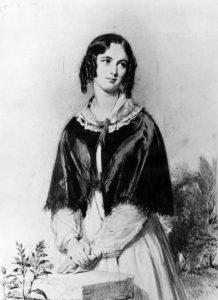
Charlotte M. Yonge
Now to examine the source for this charming and tantalizing glimpse of Jane Austen as Mrs. Candour, that comes to us through a connection with another author. Charlotte Mary Yonge, the hugely popular and prolific Victorian author (1823 – 1901) (The Daisy Chain, The Heir of Redclyffe) lived the whole of her life at Otterbourne, a village only four miles removed from Winchester. Although she was born after Jane Austen’s death, she was closely acquainted with family members and friends who had known Austen. Sir William Heathcote, the squire of her parish, a worthy man with whom Yonge worked closely on parish matters and church building, was the lifelong friend of Jane Austen’s nephew James Edward Austen Leigh. Yonge, an early Janeite who discussed and quoted Jane Austen “con amore,” loved to hear the young men’s recollections of her idol.
Sir William was born in 1801, and his mother Elizabeth was one of the Bigg sisters who were Jane Austen’s good friends. They lived at Manydown, a few miles from Steventon, a hospitable stone mansion presided over by their country gentleman father, Lovelace Bigg-Wither. Elizabeth Bigg married Rev. William Heathcote in 1798, but her husband died shortly after his son William’s birth, and Elizabeth moved back to Manydown to live with her father and still single sisters, Kitty and Alethea. She remained there with her young son until her father died in 1813, and that was how the little boy saw and was able to remember Jane Austen’s visits to Manydown.
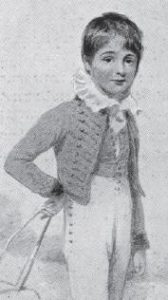
William Heathcote in 1806
It was Charlotte Yonge who wrote of how her friend William Heathcote remembered being with Jane Austen “at a Twelfth Night party when he was a small boy. He stated that on his occasion she had drawn the character of Mrs. Candour, and acted it with great appreciation and spirit.”
William and his aunts, too, liked to laughingly remember little incidents of the old Manydown days, such as their terror of the great comet of 1809 as it “stared at them in bed through the windows.” It was a happy, social family life, and included generations of continuing family intimacies with families in the neighborhood, including the Austens.
Elizabeth’s brother, young Harris Bigg-Wither inherited Manydown, around the time William and James Edward Austen-Leigh, schoolmates, entered Winchester. It was of course Harris Bigg-Wither whose proposal Jane Austen accepted, and then changed her mind about, a decade earlier, on a memorable night in 1802. This was when Harris was a callow young man, (twenty-one to Jane Austen’s nearly twenty-seven). Yet this embarrassing incident and her hasty departure, did not prevent Jane Austen from continuing her intimacy with the family, and her visits, including the Twelfth Night one William remembered.
His account is supported by Jane’s own letters. She wrote on December 27, 1808, from Castle Square, Southampton where she was living with her mother and friend Martha, to Cassandra at Godmersham:
“I was happy to hear, chiefly for Anna’s sake, that a ball at Manydown was once more in agitation; it is called a child’s ball, and given by Mrs. Heathcote to William. Such was its beginning at least, but it will probably swell into something more. Edward was invited during his stay at Manydown, and it is to take place between this and Twelfth-day. Mrs. Hulbert has taken Anna a pair of white shoes on the occasion.”
At that time, young Edward was ten years old, while his sister Anna was 15. William would have been seven, so no wonder the ball was given the character of a children’s ball, though Anna was almost a young lady. It seems that this is the Twelfth Night ball that William later remembered from his childhood, for in Jane Austen’s next letter, again from Castle Square on 10 January 1809, she writes as if she attended it herself:
“The Manydown Ball was a smaller thing than I expected, but it seems to have made Anna very happy. At her age it would not have done for me.”
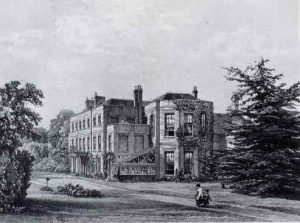
Manydown House
Note William’s wording that Jane Austen “had drawn the character of Mrs. Candour.” This is typical of Twelfth Night play-acting, when revelers drew lots to see which parts they would play in the enactments.
Wouldn’t it be fun (perhaps I must venture!) to write a little skit of Jane Austen emulating Mrs. Candour and teasing the party guests? But for now, the mere thought of her disporting herself so enjoyably is enough of a Twelfth Night delight to share. The friends and joys of Manydown were a pleasure to Jane Austen throughout her life, and significantly she writes in her first surviving letter, of 9 January 1796, when she had just turned twenty, about having danced at Manydown: “I shall proceed to inform you that we had an exceeding good ball last night,” she tells Cassandra. On this occasion her partner was none other than Tom Lefroy, for this is the letter in which she tells her sister, “Imagine to yourself everything most profligate and shocking in the way of dancing and sitting down together.”
This 1796 ball would have taken place on the 8 January, which is two days past Twelfth Night; but it is quite possible that Jane Austen, and Tom Lefroy, at Manydown, may have enjoyed the festivities and revels of that Twelfth Night as well, together.
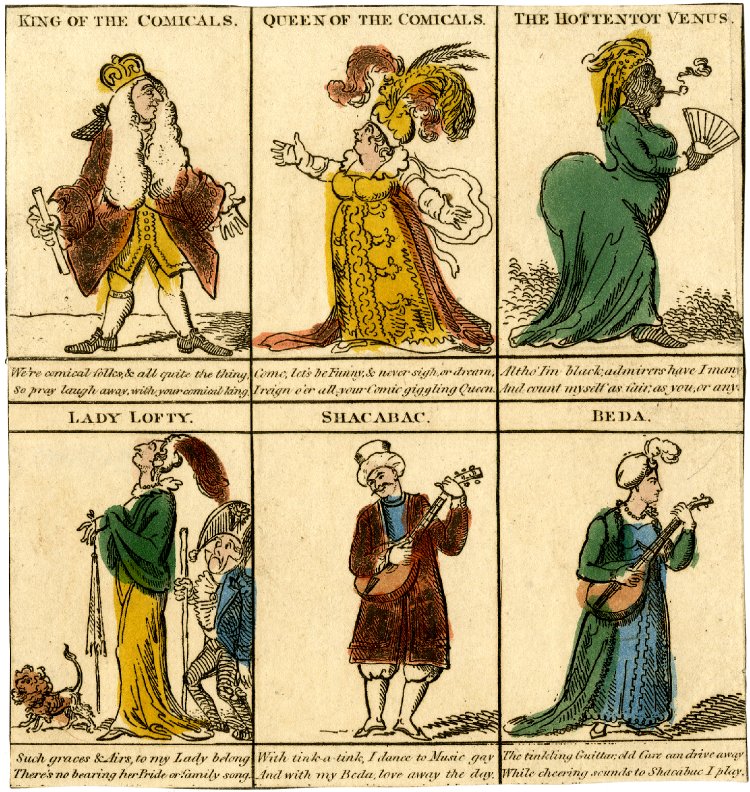
For more about Twelfth Night in Jane Austen’s day, read the delightful historical piece on Maria Grace’s blog: https://randombitsoffascination.com/2020/01/04/twelfth-night-history-ala-carte/

24 comments
Skip to comment form
Interesting. Filled with good information. The Yonge family seems to have come from this same milieu as the Mitfords, Biggs, and Austens. And this segment of the population keeping their families so much within a specific rank and money milieu, they would get to know one another and intermarry too. I looked them up in Tomalin and she has a couple of long sections on the Biggs, and Chutes and Heathcotes. William, says she, was a handsome man, very conventional looking squire, all of them very conventional (her words) Tories. Catherine Bigg was the one who married a man 30 years older than herself and proceeded to become pregnant … But no entry for Yonge.
The passage about Austen “drawing” Mrs Candour strikes the memory of anyone interested in Austen: Sheridan was the one who thought P&P such an intelligent book. It’s been many years since I read School for Scandal; I’ve seen it a couple of times but always done so blandly I’m bored.
I used to wonder if the use of the word was undergoing change at the time. Candid used to mean giving a generous interpretation to something and Austen uses it that way for Jane Bennet. But there can be a hypocritical use of candid, whereby you speak ever so sympathetically and yet drop in front of others some humiliating information which hurts the person. (Now we usually just mean frank.) Condescending has gone a similar trajectory: it used to be seen as a positive thing to do. No more. It is now putting someone in their place — lower than you of course.
I was thinking could it be that Mrs Elton was partly comprised of memories of Mrs Candour. I’d have to re-read the play but as I see Mrs Elton her use of spite is not the result of hypocritical candor but imposing her will on others in such as way as to expose someone to herself in public and in private and to others (especially a so-called friend) what their lower and contemptible (to some people) social predicament is, forcing on them some action which they don’t want and exposes this. This fits Jane Fairfax. I don’t remember any thing so subtle in The School for Scandal — no nuanced relationship like this.
Lady Catherine de Bourgh is both condescending (to us in the worst sense) and yet hypocritically candid. Very unpleasant women.
I had assumed that the occasion was one where the families acted out School for Scandal: maybe some kind of dramatic reading aloud in the room or a circle, nothing so momentous as the Bertrams with Lovers’ Vows.
I’ve been reading 18th century drama lately — following the career of Catherine Clive, and yesterday I happened to read Colman and Garrick’s The Clandestine Marriage , which has come back into the repertoire and there is even a DVD with a stellar cast: I’ve see it at the Folger and recommend it — Mrs Heidelberg is such another character as Lady Catherine, only far coarser, far more knowing sexually. She was the part that Clive played, with Clive’s friend who she mentored, Jane Pope, Miss Sterling Mrs Heidelberg’s protegee (in life Clive was Pope’s mentor and probably lesbian lover): all this might have been known to watchers. Joan Collins (from the Ealing Carry on people plays the part in the DVD). I assume Austen would have known this play too.
Author
Ellen, I do think the Austen theatricals at Steventon were quite elaborate, whole play productions. School for Scandal is one of the plays they did; the whole family was particularly fond of Sheridan, and he was clearly a big influence on Austen. I learned all about William Heathcote through several biographies of Yonge, and a biography of him by a sister. There were a lot more interconnections between the families than I’ve mentioned here – had to cut a lot, as it was getting to be too much scholarship for the post’s theme. But the curate at Otterbourne was a Bigg-Withers, Heathcote’s cousin; and Keble was Heathcote’s tutor and later rector of Otterbourne where Heathcote was squire, and Keble was Yonge’s great mentor as well. She even shared a doctor with Austen. I wrote a paper and made a study of all this years ago to no particular purpose, but I was glad to use some of it as a topic for this Twelfth Night entertainment “gift.”. And I’ll be writing more on the subject!
Edit or delete this
Ellen, I hope you’ve been reading Berta Joncus’s work on Kitty Clive. She’s been working on her for years.
Oh yes, I have — I have her articles too.
I’ve just been so touched by watching a modern production (a movie version) of The Clandestine Marriage. It ought to be done so much more often. I hope to write a blog and other pieces when I’ve done.
Thanks for sharing this picture and story of
a young Jane Austen as Mrs. Candor.
Author
You’re welcome, Joan – as you can imagine, it was a pleasure for me to write!
I can imagine Jane Austen especially enjoying this role–this is a very interesting blog that highlights the longstanding relations with the Biggs.
Author
Hi Diane, I’m so glad you found it interesting, it was a lot of pieces of research that just sort of all came together – I’ve been a deep Yonge fan for many years. Plenty of coincidence and connectedness here, what with Biggs, and Bigg-Withers, and Heathcotes, and Austens. Great fun!
Thank you for sharing this interesting information.
Author
Debbie, you’re welcome, and I’m so glad you found it interesting!
What an enjoyable post! I could read your insights on Jane Austen for hours. Thank you.
Author
Oh, Deborah, that is such a lovely thing for you to say! I appreciate it so very much! (Appreciative hugs! 🙂 )
loved learning more about this.
Author
Good, Denise! I’m just getting started! LOL.
Loved it, Diana!
Author
I’m so glad, thanks for commenting, Marcy!
Delicious read! Thanks for posting 😊
Oh, to have been a fly on the wall when Miss Austen was performing Mrs. Candour! I’ve read what survives of her letters and know what a snarky commentator on life and the behaviour of others she could be, so she’d fit very well, I’d imagine.
Many thanks for sharing these thoughts with us.
Thanks for commenting, Anji – I’m so glad you were charmed by the idea of Jane and Mrs. Candour, as I was! It was fun to research.
Yes. Ah, I remembered myself thinking that they did the play — though again not with the full paraphernalia that the Bertram players do in Mansfield Park. This Twelfth Night we are talking of was years after that period in the early 1790s when the Austens, Eliza and I believe (not sure) the cousin (she didn’t want to play if I recall rightly) did a whole bunch of plays. Jane was then just a girl; the two brothers vied for the affections of Eliza. Some memories of this went into MP later.
At the time James would write prologues or epilogues in the spirit of the commercial theater – trying for wit. The going agreed-on idea among them at the time was comedies were more fun than tragedies and years later we find Austen still stating this in her sarcastic way, but James himself writes seriously or (maybe they’d put it) gravely. I’m now half-way through reading Centlivre’s The Wonder: A Woman Keeps a Secret, and am half-remembering that was one of the plays they did. It is very late at night when I’m typing this and I’m not looking anything up so don’t vouch for any exactitude.
Yes, you’ve got it right without looking it up, Ellen – the Steventon theatricals were when Eliza was there, and Jane was about twelve years old. It’s Cousin Philadelphia who wrote sort of censoriously saying that she really would not want to act. Of course, the occasion when Jane Austen (by William Heathcote’s account anyway) played Lady Candour, would have been much later, 1808, when she was in her early 30s, and not at home but at Manydown. It’s nice to think she still got a kick out of these activities.
We don’t actually know how much paraphernalia was used in the Steventon theatricals – whether there was a real “little theatre,” green baize curtains, or what! They’re supposed to have been enacted in the barn. I’ve seen it mentioned that Jane wrote fore-pieces and after pieces for some plays, and doubtless they’d have been a contrast, in their burlesque humor, to James’s writing.
It’s James’s poems that have survived from the earlier productions. In the 1790s Jane would have been too young to produce effective heroic couplet art — which if you mean also to be nuanced, have emotional depths and ironies and wit is damned hard.
There are now editions of James’s poetry (well one complete) and of the family poetry (where we can can find Jane Austen’s). Her one truly serious effort is that elegy upon Mrs Lefroy’s death, and (let’s admit) she is bit stilted there. The other is the one recorded around the time she died. She has stanzaic poems — one about her migraines.
No, we don’t know exactly what they did or had. Some portraits of other (wealthier) families from the ear show quite a professional looking effort. In Voltaire’s Fermey they did plays regularly — had a stage for it. But theatrical art is often ephemeral and it is only in our time with our cameras and video-makers that we have been able to try to make semi-permanent what transpired. There’s a book about some 750 plus novels where upper class characters put on plays in their homes.
Thanks for sharing. I am in awe of all the research I find on these blogs. Well done.
Thank you very much, Sheila! It was great fun to do.